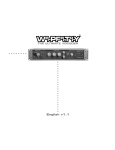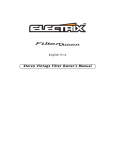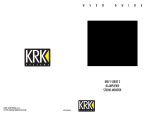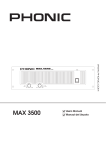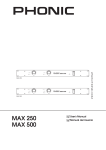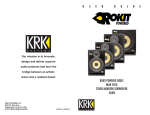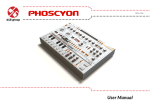Download Electrix Filter Factory Specifications
Transcript
THE ULTIMATE FILTER English v1.1 CAUTION RISK OF ELECTRIC SHOCK DO NOT OPEN A T T E N T I O N : RISQUE DE CHOC ELECTRIQUE - NE PAS OUVRIR W A R N I N G : TO REDUCE THE RISK OF FIRE OR ELECTRIC SHOCK DO NOT EXPOSE THIS EQUIPMENT TO RAIN OR MOISTURE The lightning flash with arrowhead symbol, within an equilateral triangle, is intended to alert the user to the presence of uninsulated ìdangerous voltageî within the productís enclosure that may be of sufficient magnitude to constitute a risk of electric shock to persons. The exclamation point within a equilateral triangle is intended to alert the uset to the presence of importat operating and maintenance (sevicing) instruction in the literature accomanying the product. INSTRUCTIONS PERTAINING TO A RISK OF FIRE, ELECTRIC SHOCK, OR INJURY TO PERSON IMPORTANT SAFETY INSTRUCTIONS READ AND SAVE THESE INSTRUCTIONS WARNING - When using electric products, basic precautions should always be followed, including the following: 1. Read all the instructions before using the product. 2. Do not use this product near water - for example near a bathtub, washbowl, kitchen sink, in a wet basement, or near a swimming pool, or the like. 3. This product should be used only with a cart or stand that is recommended by the manufacturer. 4. This product, either alone or in combination with an amplifier and headphones or speakers, may be capable of producing sound levels that could cause permanent hearing loss. Do not operate for long period of time at high volume level or at a level that is uncomfortable. If you experience any hearing loss of ringing in the ears, you should consult an audiologist. 5. The product should be located so that its location or position does not interfere with its proper ventilation. 6. The product should be located away from heat sources such as radiator, heat registers, or other products (including amplifiers) that produce heat. 7. Clean only with a damp cloth. Before cleaning the unit, turn off the power and unplug the power cord from the outlet. 8. The power supply cord of the product should be unplugged from the wall outlet during lightning storms or when left unused for a long periods of time. 9. Use only with attachments/accessories specified by the manufacturer. 10. The product should be serviced by qualified service personnel when: A. The power supply cord or the plug has been damaged; or B. Objects have fallen, or liquids has been spilled into the product; or C. The product has been exposed to rain; or D. The product does not appear to be operate normally or exhibits a marked change in performance; or E. The product has been dropped, or the enclosure damaged. 11. Do not attempt to service the product beyond that described in the user maintenance instructions. All other servicing should be referred to qualified service personnel. For the USA This product may be equipped with a polarized line plug ( one blade wider than the other). This is a safety feature. If you are unable to insert the plug into the outlet, contact an electrician to replace your obsolete outlet, Do not defeat the safety purpose of the plug. For Canada For Polarized Line Plug: Caution: TO PREVENT ELECTRIC SHOCK, MATCH WIDE BLADE OF PLUG TO WIDE SLOT, FULLY INSERT. Attention: POUR …VITER LES CHOCS …LECTRIQUES, INTRODUIRE LA LAME LA PLUS LARGE DE LA FICHE DANS LA BORNE CORRESPONDANTE DE LA PRISE ET POUSSER JASQUí AU FOND. For the U.K. IMPORTANT: THE WIRES IN THIS MAINS LEAD ARE COLOURED IN ACCORDANCE WITH THE FOLLOWING CODE: BLUE: NEUTRAL BROWN: LIVE As the colours of the wires in the mains lead of this apparatus may not correspond with the coloured markings identifying the terminals in you plug, proceed as follows. The wire which is coloured BLUE must be connected to the terminal which is marked with the letter N or coloured BLACK. The wire which is coloured BROWN must be connected to the terminal which is marked with the letter L or coloured RED. Under no circumstances must either of the above wires be connected to the earth terminal of the three pin plug. INTRODUCTION W elcome to the world of Electrix. We would like to thank you for purchasing FilterFactory, The Ultimate Stereo Resonant Filter for musicians, DJs, producers and engineers. FilterFactory is unique in its ease of use and its focus on directly filtering a range of input signals from turntables to CD’S to Synths. FilterFactory’s digitally controlled Analog filters were modeled after VCF’s (Voltage Controlled Filters) like those found in traditional Analog synthesizers. Use FilterFactory to re-mix your vinyl live. Just insert your FilterFactory between the turntable and the mixer and add your own filter sweeps, LFO’s and distorted signals to the mix. FilterFactory has a built in phono pre-amp, so you can plug in your turntable directly. This setup allows you to cue the effect before it goes to the house by using the cueing feature of your mixer. In the studio full MIDI implementation makes FilterFactory the perfect recording tool. You can play the FilterFactory live and capture your performance in a sequence. FilterFactory’s unique future / retro case was designed to allow both desktop and rackmount installation. This concept makes FilterFactory’s control surface perfect for live performance and studio use. " INSPECTION In your Electrix box you should find: • 1 Electrix FilterFactory • 1 Manual • 1 Rackmount kit • 1 Warranty Card • 1 EIC Power Cable (appropriate for your region) If this is not the case then please call your local Electrix distributor, agent or dealer. TABLE OF CONTENTS Introduction ............................................ 4 Inspection . . . . . . . . . . . . . . . . . . . . . . . . . . . . . . . . . . . . . . . . . . . . . . . 4 1 Quick Start ............................................. 6 2 Understanding the Product 2.1 Front Panel . . . . . . . . . . . . . . . . . . . . . . . . . . . . . . . . . . . . . . . . . . 8 2.2 Back Panel . . . . . . . . . . . . . . . . . . . . . . . . . . . . . . . . . . . . . . . . . . . 8 3.1 Setups: . . . . . . . . . . . . . . . . . . . . . . . . . . . . . . . . . . . . . . . . . . 12 3.2 Artist Applications . . . . . . . . . . . . . . . . . . . . . . . . . . . . . . . . . . . . 15 4 MIDI Applications 4.1 Recording Performances to a Sequencer . . . . . . . . . . . . . . . . . . 17 4.2 MIDI Implementation Chart . . . . . . . . . . . . . . . . . . . . . . . . . . . . 18 5 Specifications . . . . . . . . . . . . . . . . . . . . . . . . . . . . . . . . . . . . . . . . . . . 19 6 Safety & Conformity . . . . . . . . . . . . . . . . . . . . . . . . . . . . . . . . . . . . 20 Français . . . . . . . . . . . . . . . . . . . . . . . . . . . . . . . . . . . . . . . . . . . . . . . . . .23 Deutch . . . . . . . . . . . . . . . . . . . . . . . . . . . . . . . . . . . . . . . . . . . . . . . . . . .43 Español . . . . . . . . . . . . . . . . . . . . . . . . . . . . . . . . . . . . . . . . . . . . . . . . . .63 English 3 Performance Guide 5 1. QUICK START 1.1 WHAT TO PLUG IN Here’s the simplest way to get sound out of your Electrix FilterFactory: Plug in AC here. Turn it on. U se these line level outputs to connect to your mixer or power amplifier. Turn on the phono pre-amp. P lug in your turntable here. 1.2 WHAT TO DO D istortion level can be louder than the program level if desired. U se the momentary button to play the effect. As you tap it, the effect will momentarily engage. When you engage an effect block, the momentary button switches its function and mutes the effect. Distortion Gain 7 O peration linked to Type setting. Low pass is the standard synth setting OverridesTap Tempo W hen engaged, the momentary triggers the filter mod for the number of cycles set by the division control. E " nv Follow" adjusts filter frequency according to the dynamics of the input signal Momentary control kicks in the filter unless the Single Shot control is engaged. When Single Shot is on, this button will tyrigger modulation. Adjusts the amount of mod effect on the filter R esonance peak control can go into self oscillation. English Global Bypass 2. UNDERSTANDING THE PRODUCT 2.1 FRONT PANEL N ote that there are no input or output controls. FilterFactory is set up to give you unity gain when bypassed or when the Mix control is at 0%. This means that signals running through it are not boosted or reduced in gain. If you are using a line level input (as opposed to a turntable) set the output of your source so that FilterFactory’s Input Level LED doesn’t go Red all that often. Try to keep your levels in the green which is the optimum level for FilterFactory. " 0 -10 -20 " Trim: Sets the output level of the -30 Buzz circuit. This can be set anywhere from inaudible to extremely loud. Use with caution. -40 Fig. 1: High Pass Filter Buzz Buzz sets the amount of distortion. The more buzz, the more distortion you will have. Buzz will take you from subtle, at the Cutoff point farthest left, to heavy distortion at the farthest right. -3 dB NOTE: Buzz will increase the level of your output signal substantially as you turn it up. Use the Trim control to get the level back to where you want it dB while the Buzz circuit is engaged. -50 10 " 20 30 50 70 100 200 Buzz Engage: Toggles the buzz 300 500 700 1000 2,000 3,000 5,000 7,000 10,000 FREQUENCY circuit in and out. " StereoFilter: Frequency: Sets the 0 -3 dB -10 dB -20 Bandwidth -30 -40 resonant frequency of the stereo filter. Use it in conjunction with the resonance control. The more resonance FREQUENCY you use the more distinct any changes you make with frequency will be. The frequency tuning range of the filter covers a 12 octave range from 10 Hz to 40 kHz. The External CV input can control this and has been adjusted to provide standard 1 Volt/Octave response. -50 10 " 20 30 50 70 100 200 300 500 700 1000 2,000 3,000 5,000 7,000 10,000 Filter Type: This control selects the basic sound of the filter. Each filter type has a unique sound. You will find situations where each one offers you a unique effect on a given signal. The High Pass will roll off the bass of your signal. It will make things sound thinner. (See Fig. 1) The Band Pass filter acts like Wah pedal and puts a peak in the middle of your signal. (See Fig. 2) This is great for hilighting certain frequency ranges or for creating a sweeping sound with the frequency knob. The Notch Filter works the exact opposite of the Band Pass filter. It puts a notch in your signal, essentially killing a small frequency band. This effect often sounds like talking through a pipe. It will also create unique sweeping sounds, (that is similar to a phase shifter) when used in conjunction with the frequency knob. For best Notch result put the Resonance knob fully counter-clockwise. Fig. 2: Band Pass Filter " Buzz Momentary: Temporaily engages the buzz circuit. This is useful for tapping patterns to create distortion hits and rhythms. Note: When an effect is engaged, the Momentary will dis-engage it, when an effect is not engaged the momentary will engage it. 2.1 FRONT PANEL The Low Pass Filter is the most commonly used filter type. This is the kind of filter you will find on vintage synths and envelope followers. It is useful for controlling the amount of harmonics or the brightness of a signal. As you sweep the frequency control, try adding some resonance to make the cutoff frequency more audible. " Filter Engage: This control toggles the filter on and off. Turning this on restarts the LFO or triggers it if it is in single shot mode. " Filter Momentary: This switch temporarily engages the stereo filter. Try using it to tap rhythmic patterns while adjusting the frequency knob. Pressing this button also restarts the LFO. dB -20 Bandwidth -30 -50 10 20 30 50 70 100 200 300 500 700 1000 2,000 3,000 5,000 7,000 10,000 FREQUENCY Cutoff point 0 -3 dB -10 dB 100 Hz Sine wave -20 -30 4 Pole Mono: The 1,000 Hz Sine wave FilterFactory operates in a Stereo 2 Pole filter per channel mode, ( unless you switch to 4 Pole mode). When FREQUENCY in Four Pole mode, the FilterFactory switches into Mono operation by summing the left and right channels before the 4 pole filter. A two pole filter will give you a gentler response, in technical terms it is defined as a 12dB/octave filter. A 4 pole or 24dB/octave filter will give you a much steeper filter response that will sound more pronounced. -40 -50 10 20 30 50 70 100 200 300 500 700 1000 2,000 3,000 5,000 7,000 10,000 9 English -40 Fig. 4: Low Pass Filter " -10 Resonance: This controls the level of the peak at the resonant frequency of the filter, i.e. the frequency you dialed in with the frequency knob. FilterFactory was designed to create extreme effects, so be careful because the resonance control is able to cause the filters to self-oscillate at higher settings. Self oscillation produces a loud tone at the resonant frequency. It sounds a lot like sustained feedback. -3 dB Fig. 3: Notch Filter " 0 UNDERSTANDING THE PRODUCT 2.2 FRONT PANEL LFO " " Tap Tempo: The tap tempo button is another way to control the LFO rate to match the beat of your music. When it is hit one time, it will restart the LFO at the beginning of its waveform. If it is hit twice within 2 seconds, then the time between presses is used as the new rate or tempo. It is hit 3 or more times, it will average the time between presses to come up with a more accurate tempo. " Depth: This controls the amount the LFO changes the filter frequency. " Speed: LFO Speed controls the period of the LFO waveforms by changing the frequency of the LFO. The LFO Frequency range covers 0.1 Hz to 100 Hz for subtle to extreme effects. " Division: The LFO rate, as defined by Tap Tempo or MIDI clock can be divided (or doubled) using this control. The actual rate is indicated by the flashing tempo LED. GLOBAL " Effect Mix: Controls the Mix of the Buzz and Filter Sections in relation to your dry signal. 0% is all dry, or the same as bypassing the FilterFactory. 100% will be all FilterFactory and none of your dry signal. " Bypass: Bypasses both effect blocks. Waveforms " Waveform: The LFO provides the following cyclic (or repetitive) waveforms: Sawtooth, Inverse Sawtooth, Triangle, Square Wave, Envelope Follow and Random. If you increase the LFO depth and turn the LFO speed up a bit you will be able to hear their effect on your frequency setting. Note: Although ENV Follow isn’t a waveform we put it here anyway. To get it working, select ENV Follow, set the frequency down to 115Hz, on a Low Pass Filter, set your • Sawtooth resonance to 7.5 and adjust the LFO depth to taste. • Inverse Sawtooth Singleshot: This button changes how the Filter and • Triangle the LFO Sections on your FilterFactory. Singleshot gives you the ability to trigger Filter Effects in a simular way •Square that playing a note on an old synthesizer will trigger VCF and VCA Envelopes. The FilterFactory Singleshot Envelopes are borrowed from the LFO section. When single shot is on, Triangle, Sawtooth, and Inverse Sawtooth all become triggerable envelopes. The Division button allows you to select how many time the waveform envelope will trigger. LFO Speed adjusts the duration of the envelope, and the Filter Momentary triggers the envelope. Note: Singleshot does not work when the ENV Follower is selected. Note 2: If the Filter is not engaged, the Singleshot does not automatically finish the waveform. UNDERSTANDING THE PRODUCT 2.3 BACK PANEL " Power input: This input will accept an IEC standard power cable. The internal power supply can be used in any region. The fuse drawer can be rotated to accomodate the different power ratings around the world. Check the chart printed near the power entry for fuse ratings. " Power Switch: Turns the FilterFactory on and off. When turning on your equipment be sure to turn your power amplifiers on last. This will ensure that the noise common to mixers and signal processors does not cause damage to your speaker system. When powering down, be sure to turn your power amplifiers off first. CV left and right: If you’ve got an old CV / Gate keyboard rig, FilterFactory will work in your current setup. You can control the Filter’s frequency with a CV signal. (1 volt per octave). " Footswitch: Use a standard momentary footswitch to turn Bypass on and off. FilterFactory can accept normally open or normally closed footswitches. The footswitch must be inserted before power is turned on so that FilterFactory can recognize its type. " MIDI In/Out/Thru: Connect MIDI devices here. See the MIDI Applications section for more detail. " Channel Select: This selects the MIDI send and receive channel. " Output: RCA -stereo - The RCA output level is nominally +4 dBu 1/4”-stereo TRS- This output produces a balanced +4 dBu signal. " Input: Phono/Line Switch - this swiches the RCA inputs to accept phono or line level. RCA. -stereo - When the Phono/Line switch is in the Line position, this input is optimized for a +4dBu input signal. When the Phono/Line switch is set to Phono, the RIAA phono pre-amp will accept a range of cartridge output levels. 1/4” -stereo TRS Balanced - This input is optimized for +4 dBu input signal. When using the 1/4” inputs, be sure to use the 1/4” outputs as well. This will ensure no noticeable signal loss. Note: Connecting both RCA and 1/4 inch jacks to the input causes the level of the 1/4” input to drop. Make sure that when you are using the 1/4” inputs that nothing is connected to the RCA inputs. English " 11 PERFORMANCE GUIDE 3.1 SET UPS Pre-Mixer he advantage of this setup in a live situation is that the FilterFactory effect can be auditioned (cued) while other sources are playing. A caution though; it is possible to get a large amount of gain with higher resonance settings, so when auditioning FilterFactory through headphones keep the level low and be careful with high settings of the Resonance control. T or or Line In PERFORMANCE GUIDE 3.1 SET UPS Mixer with Aux Send T his setup requires a mixer with auxiliary (aux) send and return capabilities. All sources are connected directly to the mixer channel inputs. FilterFactory is fed its signals from the mixer’s aux sends. This setup allows any or all of your sound sources to be processed through FilterFactory at any time. The mix control on FilterFactory should be set to 100% wet so that the dry source signal is only heard through the mixer. 13 English Mic in Line in Line in Phono in Aux Out Aux In PERFORMANCE GUIDE 3.1 SET UPS Post Mixer T his is a simple setup for stereo processing of your entire mix. You’ll want to use this setup only after you have explored all the sonic possibilities of FilterFactory because cueing is not possible. The cueing limitation can be minimized by bringing in the effect gradually with FilterFactory’s mix control and doing any adjustments from there. The 1/4” output jacks have servo driver circuits which are capable of driving longer cables to your power amp. Also, this setup comes with a warning: WATCH THAT RESONANCE CONTROL! Like any true analog filter, FilterFactory is capable of generating ear- and PA-shredding peaks when you increase the resonance control beyond halfway. Have we made this point enough? Line in Phono in Line Out to Crossover/Power Amp PERFORMANCE GUIDE 3.2 ARTIST APPLICATIONS "Tap Tempo Filter Swoosh "Phase Shifter effect That swooshy sound, that was initially made popular as a Fender Rhodes effect, is also available in the FilterFactory. This effect works especially on sounds with sustained portions such as voice, synth pads and of course, Fender Rhodes. A bass track with the Buzz engaged and Notch filtering is awesome. Buzz: optional Frequency Knob: 115 plus 2 ticks Type: Notch Resonance Knob: 0 4 Pole Mono: On Waveform: Triangle (looks like mountains) Singleshot: Off Depth: 10 Speed: Experiment - slow is good, medium warble is nice too. Division: Off Effect Mix: 100 % 15 English Buzz: optional Frequency Knob: 640 Type: Low Pass, High Pass Resonance Knob: Above 2.5 to as high as you dare. 4 Pole Mono: On, but if you want 2 Pole stereo, turn up the Resonance and Depth more. Waveform: Try Ramp Dwon first, then try the other waveforms. Singleshot: On Depth: 5 Speed: 9 O’Clock to 12 O’Clock on the knob Division: 1:1 to start. Try the other divisions with faster Speed settings. Effect Mix: 100 % or to taste PERFORMANCE GUIDE 3.2 ARTIST APPLICATIONS "Funk Drum FX You can use the Envelope Follower waveform in the LFO section to create a “Bwow” sound that exactly follows the dynamics of rhythmic input. Here’s how it’s done: Buzz: off Frequency Knob: 115 Type: Band Pass Resonance Knob: 2.5 4 Pole Mono: Off Waveform: EnvFollow Singleshot: Off Depth: Less than 10 Speed: Off Division: Off Effect Mix: To taste Playing with the Depth and Frequency knobs will customize the effect to your liking. Changing the Filter Type will emphasize different frequency bands. Note that when you try the Notch filter type setting, you’ll have to set resonance to zero and the frequency knob to around 640. MIDI 4.1 RECORDING AND PLAYING BACK PERFORMANCES WITH A SEQUENCER E lectrix products are performance products. We have designed them to accurately transmit and receive your performance through MIDI. That means every knob and every switch can be automated. To do this, simply connect your FilterFactory to a sequencer. FilterFactory has MIDI Control Change messages assigned to all of it’s functions. That means your performance will show up in your sequencer as MIDI CC’s (Control Change Messages). Note that a press and hold of the bypass button will dump the present state of the controls. MIDI CC #18 will request a dump of state. " Real Time Control " MIDI Clock The FilterFactory can receive MIDI clock messages. It will re-sync its Tap Tempo to the incoming MIDI clock for you automatically. This could be a great convenience for you if have a Drum Machine or Groovebox to sync to. Just set up your MIDI clock source to transmit MIDI clock, connect a MIDI cable from the source’s MIDI OUT to the FilterFactory’s MIDI in and press start on your MIDI clock source. Note: The LFO speed control overrides the Tap Tempo and the incoming MIDI clock tempo. That means if you adjust it you will loose sync to your Tap Tempo / MIDI Tempo. To re-sync to MIDI Clock, hit Tap Tempo. " Setting the MIDI Channel On the back of your FilterFactory is a small rotary switch labeled MIDI channel. Use it to set the Transmit / Receive channel of your FilterFactory. English The FilterFactory has a great alternative MIDI control feature. You can control the frequency control with your keyboard using MIDI Note Numbers. Here’s how...set the filter to self resonate by bring the resonance up quite high, then play monophonically on a keyboard plugged into the MIDI in on the FilterFactory for some pitched effects. 17 MIDI 4.2 MIDI IMPLEMENTATION CHART Function Basic Channel Mode Note Number Velocity Selectable Default Messages Note ON Note Off After Touch Pitch Bender Control Change Program Change System Exclusive System Common System Real Time Aux Messages Transmitted 1-16 X X X X X X X Recognized 1-16 Mode 3 X 0 X X X O X X X X X X X X X X X X X X X X 0 0 X X X X 1 2 3 4 5 6 7 81 9 102 113 12 134 165 17 18 67 Song Position Song Select Tune Request Clock Commands Local On/Off All notes Off Active Sensing System Reset Remarks Controls Filter Frequency Controls Filter Frequency LFO Depth (Mod Wheel) Pre-Buzz Level Post-Buzz Level Buzz Engage Filter Frequency Wet / Dry Mix Filter Resonance Filter Type Filter Engage LFO Waveform LFO Single Shot LFO Rate LFO Division Filter Poles Bypass Dump Request Tap Tempo Tempo (LFO Speed) Restarts LFO in sync with MIDI clock Notes 1. Filter Type: 0 (low pass), 1 (high pass), 2 (band pass), 3 (notch) 2. LFO Waveform: 0 (sawtooth), 1 (inverse sawtooth), 2 (triangle), 3 (square), 4 (random), 5 (envelope follow) 3. LFO Single Shot, 0-63 (continuous LFO waveform), 64-127 (single shot LFO waveform) 4. LFO Division: 0 (1:1) 1 (2:1) 2 (3:1) 3 (4:1) 4 (6:1) 5 (1:2) 6 (1:4) 5. Filter Poles: 0-63 (2-pole), 64-127 (4-pole) Mode 1: OMNI ON, POLY Mode 3: OMNI OFF POLY Mode 2: OMNI ON, MONO Mode 4: OMNI OFF MONO 0: YES X: NO SPECIFICATIONS INPUT Connectors: (balanced) Max Input Level: Impedance: 1/4” TRS RCA (Phono) RCA (Line) +12.5 dBu 110KΩ -24.5dBV 47.5KΩ +12.5dBu 20KΩ OUTPUT PERFORMANCE Dynamic Range: THD: Frequency Response: 19 1/4”TRS bal 600Ω +12.5 dBu RCA 1KΩ +12.5 dBu RCA 1KΩ +12.5 dBu 1/4” >90db <0.3% 10Hz-20.0kHz PHONO >75db <0.3% 10Hz-20.0kHz RCA <90db <0.3% 10Hz-20.0kHz POWER CONSUMPTION 30 watts VOLTAGE 100 V 120 V 230 V 240 V Actual measurements are subject to change FREQUENCY 50/60 Hz 50/60 Hz 50/60 Hz 50/60 Hz FUSE 250mA 250V Slow blow 125mA 250V “T” English OUTPUTS Connectors: Impedance: Max Output Level: SAFETY & CONFORMITY This equipment has been tested and found to comply with the limits for a class A digital device, pursuant to part 15 of the FCC rules. These limits are designed to provide reasonable protection against harmful interference in a residential installation. This equipment generates, uses and can radiate radio frequency energy and, if not installed and used in accordance with the instructions, may cause harmful interference to radio communications. However, there is no guarantee that interference will not occur in a particular installation. If this equipment does cause harmful interference to radio or television reception, which can be determined by turning the equipment on and off, the user is encouraged to try to correct the interference by one or more of the following measures: • Reorient or relocate the receiving antenna. • Increase the separation between the equipment and the receiver. • Connect the equipment into an outlet on a circuit different from that to which the receiver is connected. • Consult the dealer or an experienced radio TV technician for help. The user may find the following booklet, prepared by the Federal Communications Commission, helpful: “How to identify and Resolve Radio/TV interference Problems.” This booklet is available from the US Government Printing Office, Washington, DC 20402, Stock No. 004-000-0034-4. " Caution: You are cautioned that any change or modifications not expressly approved in this manual could void your warranty. " For the customers in Canada: This Class A digital apparatus meets all requirements of the Canadian Interference-Causing Equipment Regulations. Cet appareil Numerique de la Classe A respecte toutes les exigences du Reglement sur le materiel brouilleur du Canada. " Certificate of Conformity Electrix, (a Div. of IVL Technologies LTD) hereby declares on own responsibility that the following product Electrix FilterFactory that is covered by this certificate and marked CE-label conforms with the following standards: • EN 60065 Safety requirements for mains operated Electronic and related apparatus for household and similar general use • EN 55103-1 Product family standard for audio, video, audio-visual and entertainment lighting control apparatus for professional use. Part 1: Emission • EN 55103-2 Product family standard for audio, video, audio-visual and entertainment lighting control apparatus for professional use. Part 1: Immunity With reference to regulations in following directives: 72/23/EEC, 89/336/EEC as amended by directive 93/68/EEC Issued in Victoria, March 31, 1999 by Brian Gibson, Executive Vice-President, Research and Development



















